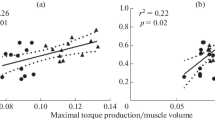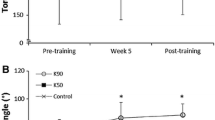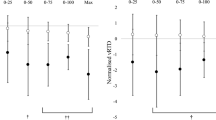Summary
The relationship between maximum isometric strength and muscle fiber type composition was examined in seven endurance and eight power trained athletes. Knee extension strength and ankle extension strength was assessed on 10 separate days and muscle biopsies were taken from the vastus lateralis and gastrocnemius muscles. The percent composition of slow twitch (ST) fibers and fast twitch (FT) fibers was determined from the biopsy samples. Correlation between maximal knee extension strength and percent ST fibers of the vastus lateralis was found to be 0.80 (n=8, p<0.05) for the power group and 0.63 (n=7, N.S.) for the endurance group. Corresponding correlation coefficients for the relationship between ankle extension strength and gastrocnemius percent ST fibers were −0.94 (p<0.01) and −0.19 (N.S.), respectively. The results suggest that the relationship to be expected between muscle fiber type composition and maximum isometric strength may well depend upon the muscle group under study as well as the type of athlete in terms of specific training adaptations.
Similar content being viewed by others
References
Bergstrom J (1962) Muscle electrolytes in man. Scand J Clin Lab Invest [Suppl] 68: 11–13
Brooke MH (1979) Some comments on neural influence on the two histochemical types of muscle fibers. In: Briskey EJ, Cassens RG, Marsh BB (eds) The physiology and biochemistry of muscle as a food, vol 2. University of Wisconsin Press, Madison, pp 131–153
Costill DL, Daniels J, Evans W, Fink W, Krakenbuhl G, Saltin B (1976) Skeletal muscle enzymes and fiber composition in male and female track athletes. J Appl Physiol 40: 149–154
Edstrom L, Ekblom B (1972) Difference in sizes of red and white muscle fibers in vastus lateralis of musculus quadriceps femoris of normal individuals and athletes. Relationship to physical performance. Scand J Clin Lab Invest 30: 175–181
Gollnick PD, Armstrong RB, Saltin B, Saubert CW IV, Sembrowich WL, Sheperd RE (1972) Effect of training on enzyme activity and fiber composition of human skeletal muscle. J Appl Physiol 33: 312–319
Hulten B, Thorstensson A, Sjodin B, Karlsson J (1975) Relationship between isometric endurance and fiber types in human leg muscles. Acta Physiol Scand 93: 135–138
Jansson E, Kaijser L (1977) Muscle adaptation to extreme training in man. Acta Physiol Scand 100: 315–324
Komi PV, Rusko H, Vos J, Vihko V (1977) Anaerobic performance capacity in athletes. Acta Physiol Scand 100: 107–114
Nilsson J, Tesch P, Thorstensson A (1977) Fatigue and EMG of repeated fast voluntary contractions in man. Acta Physiol Scand 101: 194–198
Nygaard E, Nielsen E (1978) Skeletal muscle fiber capillarization with extreme endurance training in man. In: Eriksson B, Furberg B (eds) Swimming medicine, vol 4. University Park Press, Baltimore, pp 282–296
Padykula HA, Herman E (1955) The specificity of the histochemical for adensine triphosphate. J Histochem Cytochem 3: 170–195
Polgar J, Johnson MA, Weightman D, Appleton D (1973) Data on fiber size in thirty-six human muscles: An autopsy study. J Neurol Sci 19: 307–318
Saltin B, Henriksson J, Nygaard E, Andersen P (1977) Fiber types and metabolic potentials of skeletal muscles in sedentary man and endurance runners. Ann NY Acad Sci 301: 3–29
Song SK, Shimada N, Andersen PJ (1963) Orthogonal diameters in the analysis of muscle fiber size and form. Nature 200: 1220–1221
Stilwill EW, Sahgal V (1977) Histochemical and morphologic changes in skeletal muscle following cervical cord injury: A study of upper and lower motor neuron lesions. Arch Phys Med Rehabil 58: 201–206
Tesch P, Karlsson J (1978) Isometric strength performance and muscle fiber type distribution in man. Acta Physiol Scand 103: 47–51
Thorstensson A (1976) Muscle strength, fiber types and enzyme activities in man. Acta Physiol Scand [Suppl] 443: 1–45
Thorstensson A, Larsson L, Tesch P, Karlsson J (1977) Muscle strength and fiber composition in athletes and sedentary men. Med Sci Sports 9: 26–30
Author information
Authors and Affiliations
Rights and permissions
About this article
Cite this article
Clarkson, P.M., Kroll, W. & McBride, T.C. Maximal isometric strength and fiber type composition in power and endurance athletes. Europ. J. Appl. Physiol. 44, 35–42 (1980). https://doi.org/10.1007/BF00421761
Accepted:
Issue Date:
DOI: https://doi.org/10.1007/BF00421761




